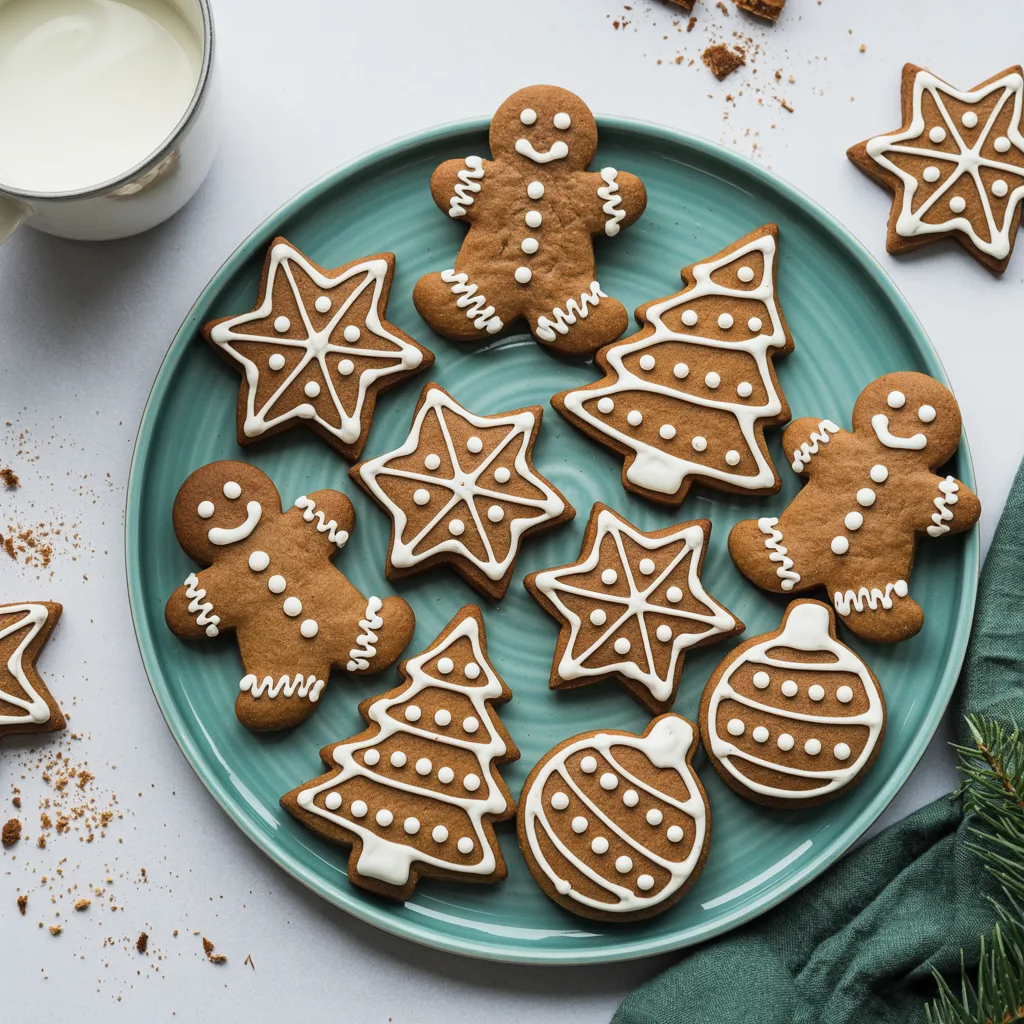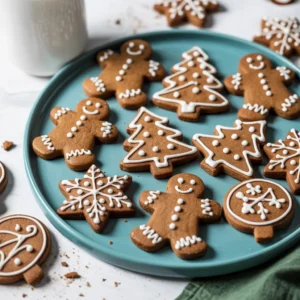The smell of gingerbread baking in the oven is one of those scents that instantly takes me back to childhood. Every December, my mother would pull out her worn recipe card, speckled with molasses stains and faint pencil notes from years past.
The kitchen would come alive with warmth—ginger, cinnamon, and cloves mingling in the air as my siblings and I cut out shapes with old metal cookie cutters.
My job was always to press the dough scraps together for “extra cookies,” which usually came out a little misshapen but were always the first to be eaten. As I got older, I realized that gingerbread cookies weren’t just about baking—they were about marking time, creating memories, and filling your home with something that felt like love.
These days, I make them for my own family, and no matter how busy life gets, I still find time for this small ritual.

Why You’ll Love This Recipe
- Classic holiday flavor that never goes out of style
- Soft and chewy with just the right snap of spice
- Perfect for decorating or gifting to friends and neighbors
- Easy dough that rolls and cuts beautifully
- Freezer-friendly and great for make-ahead baking
Ingredients You’ll Need
For the Cookies:
- 3 cups all-purpose flour: Spoon and level it for accuracy. I’ve tried using half whole wheat before—it works, but the cookies turn out a bit denser and darker.
- ¾ cup unsalted butter, softened: Room temperature is key. Cold butter won’t mix properly, and melted butter will make the dough too greasy.
- ¾ cup brown sugar, packed: I prefer dark brown sugar for that deep molasses flavor, but light brown works too.
- ⅔ cup molasses: The heart of any gingerbread cookie. Use unsulfured molasses (not blackstrap—it’s too bitter).
- 1 large egg: Brings everything together. I once forgot it and ended up with crumbly dough that wouldn’t hold a shape.
- 1 teaspoon baking soda: Helps the cookies puff just slightly and stay tender.
- ½ teaspoon salt: Balances the sweetness.
- 1 tablespoon ground ginger: The backbone of the flavor—don’t be shy here.
- 1 ½ teaspoons ground cinnamon: Adds warmth that rounds out the spice.
- ¼ teaspoon ground cloves and ¼ teaspoon nutmeg: Just enough to give the cookies a little depth and bite.
For Decorating (Optional):
- 2 cups powdered sugar: For simple icing or royal icing.
- 2–3 tablespoons milk or lemon juice: Adjust for consistency.
- Food coloring and sprinkles: If you’re decorating with kids or want to make festive designs.
How to Make It (Step-by-Step Instructions)
Step 1: Cream the Butter and Sugar
Start by creaming the softened butter and brown sugar together in a large bowl until the mixture looks fluffy and lighter in color—about 2–3 minutes with a hand or stand mixer. This step isn’t just about mixing; it’s about creating air pockets that give your cookies a tender bite. When I first started baking, I rushed through this part and wondered why my cookies turned out dense. Now I take my time, scraping down the sides of the bowl as I go.
Step 2: Add the Molasses and Egg
Once the butter and sugar are well blended, pour in the molasses and beat until it’s fully incorporated. The mixture will look glossy and dark—almost like caramel. Then add the egg and mix again. Don’t worry if the batter looks slightly curdled; it will come together once you add the dry ingredients.
Step 3: Combine the Dry Ingredients
In a separate bowl, whisk together the flour, baking soda, salt, ginger, cinnamon, cloves, and nutmeg. I always sift the spices first to make sure there are no clumps—it helps them distribute evenly. Slowly add the dry ingredients to the wet mixture, about a cup at a time, mixing on low speed until the dough comes together. It should feel soft but not sticky. If it’s too wet, add a tablespoon or two of flour; if too dry, drizzle in a bit of milk.
Step 4: Chill the Dough
Divide the dough in half, flatten each piece into a disc, and wrap them tightly in plastic wrap. Chill for at least 1 hour, or up to overnight. This step is crucial—cold dough rolls out smoothly, holds its shape, and prevents spreading in the oven. I once skipped chilling because I was impatient, and my cute gingerbread men turned into puffy, unrecognizable blobs.
Step 5: Roll and Cut
Preheat your oven to 350°F (175°C). Lightly flour your work surface and rolling pin, then roll out one disc of dough to about ¼ inch thick. Cut out shapes using your favorite cookie cutters. If you’re doing intricate shapes, dip the cutter in flour each time to prevent sticking. Gather the scraps, re-roll, and cut again until all the dough is used.
Step 6: Bake
Place the cookies on parchment-lined baking sheets about an inch apart. Bake for 8–10 minutes, depending on the size of your cookies. Keep a close eye—smaller shapes may need less time, while larger ones might take a minute or two more. The edges should be firm and just slightly darker. Remember, gingerbread cookies continue to firm up as they cool, so don’t overbake them or they’ll lose that perfect chew.
Step 7: Cool and Decorate
Let the cookies cool on the baking sheet for a few minutes before transferring them to a wire rack. Once completely cool, decorate with icing, sprinkles, or leave them plain if you prefer the rustic look. I often make a simple glaze from powdered sugar and lemon juice—it’s bright and balances the sweetness beautifully.

Expert Tips for the Best Results
The most important thing I’ve learned over years of making gingerbread cookies is that the dough tells you what it needs. If it’s too sticky, a bit of flour will calm it down. If it cracks when you roll it, let it rest at room temperature for ten minutes. Always chill your dough thoroughly and bake on the middle rack for even heat. If you prefer softer cookies, roll the dough slightly thicker; for crisp ones, roll it thinner. Don’t skip cooling before decorating—warm cookies will melt your icing into a sugary mess. And finally, don’t be afraid to double the batch. These cookies disappear faster than you’d think.
Variations & Substitutions
Over the years, I’ve played around with this recipe to suit whatever ingredients I had on hand. Once, I ran out of molasses and substituted part maple syrup and part honey—the cookies came out lighter in color but still delicious. You can also add finely chopped candied ginger for an extra bite, or a touch of orange zest to brighten the flavor. For a more adult version, I’ve brushed the tops with a little spiced rum glaze after baking—it gives them a wonderful aroma. If you want to make them vegan, use coconut oil instead of butter and a flaxseed egg; the texture changes slightly, but the flavor remains comforting and warm.
Serving Suggestions
I love serving these gingerbread cookies alongside a mug of hot tea, mulled cider, or even coffee on a chilly afternoon. They’re wonderful for holiday gatherings, cookie exchanges, or packaged in small boxes as homemade gifts. Around Christmastime, I hang a few on the tree with ribbon for a nostalgic touch. They also make a lovely addition to dessert boards with chocolate-dipped pretzels and spiced nuts.
Storage & Reheating Instructions
These cookies keep beautifully. Store them in an airtight container at room temperature for up to a week, or freeze for up to three months. If they start to lose their softness, place a slice of fresh bread in the container overnight—the moisture helps revive them. Gingerbread doesn’t really need reheating, but if you want that just-baked aroma again, a few seconds in the microwave will do the trick. The icing will soften slightly, so be gentle.
Recipe FAQs (Answered by Clara)
Can I make this ahead of time?
You sure can. I often prepare the dough the night before, wrap it tightly, and keep it chilled in the fridge. It actually rolls out better after resting, and the flavors deepen beautifully.
Can I use store-bought icing?
Of course. I’ve used store-bought royal icing more times than I can count when I’m short on time. It’s convenient, and a few drops of vanilla or lemon extract can make it taste homemade.
Can I make them gluten-free?
Yes, I’ve had good results using a 1:1 gluten-free flour blend. The dough tends to be a little softer, so chilling is even more important. Handle gently when rolling and cutting.
How do I keep them from getting too hard?
Don’t overbake them. Pull them out of the oven as soon as the edges are set but the centers still look soft. They’ll firm up as they cool. Also, keep them stored in a sealed container to prevent drying out.

Conclusion
Every time I bake these gingerbread cookies, I’m reminded that recipes like this are more than instructions—they’re traditions that keep us connected to our past and to one another. Whether you make them with children, friends, or in the quiet of your own kitchen, there’s something grounding about rolling dough, cutting shapes, and breathing in that unmistakable aroma of spice and molasses. I hope this recipe brings as much joy to your home as it has to mine. If you give it a try, I’d love to hear how it turns out—share your favorite decorating ideas or your own family memories. That’s how the best recipes live on.
Nutrition Information (per cookie, approx.):
Calories: 120 | Fat: 4g | Carbohydrates: 20g | Protein: 2g | Sugar: 11g | Sodium: 90mg

Gingerbread Cookies
Ingredients
- 3 cups all-purpose flour
- ¾ cup unsalted butter softened
- ¾ cup brown sugar packed
- ⅔ cup molasses
- 1 large egg
- 1 tsp baking soda
- ½ tsp salt
- 1 tbsp ground ginger
- 1 tbsp ground cinnamon
- ½ tsp ground cloves
- ½ tsp ground nutmeg
For decoration (optional):
- Royal icing
- Sprinkles or sanding sugar
Instructions
- Cream butter and sugar: In a large mixing bowl, beat butter and brown sugar together until light and fluffy.
- Add wet ingredients: Mix in molasses and egg until fully combined.
- Combine dry ingredients: In a separate bowl, whisk together flour, baking soda, salt, ginger, cinnamon, cloves, and nutmeg.
- Form dough: Gradually add dry ingredients to the wet mixture, stirring until a thick dough forms.
- Chill: Divide the dough in half, flatten into discs, wrap in plastic wrap, and refrigerate for at least 2 hours.
- Roll and cut: Preheat oven to 350°F (175°C). On a lightly floured surface, roll out dough to ¼-inch thickness. Cut into desired shapes.
- Bake: Place cookies on parchment-lined baking sheets and bake for 8–10 minutes, until edges are set.
- Cool and decorate: Let cookies cool completely before decorating with icing or sprinkles.
Notes
- For softer cookies, bake just until the edges are firm and the centers are still slightly soft.
- Add a touch of black pepper for a subtle spice kick.
- The dough can be made ahead — refrigerate up to 3 days or freeze up to 3 months.
- Royal icing hardens beautifully for decorating and packaging.

